Introduction
The Western world turned grey in the 20th century and much of the rest of the world will follow this century. Improvements in housing, sanitation, nutrition and education, and smaller family size, higher incomes and public health measures such as immunization were the major factors driving this epidemiological transition. In many developed countries, this shift started in the mid-19th century and life expectancy increased as infant and maternal mortality and deaths from infectious diseases in children and young adults fell. Over the last 30 years, gains in life expectancy are also being made in middle age. In countries such as Japan the transition started later but proceeded more quickly. In many developing countries, the transition started even later and is still in progress.
In the West, the impact of an ageing population on the retirement age, pensions and the cost and practicalities of service provision has become an important issue. An increasingly small number of people of working age cannot fund the pensions of older people with ever longer retirements. Most older people are independent, but if they need help, family care is often not available; many of their daughters will be working, families are scattered geographically and options for care are less well developed than child care.
The common afflictions of old age are now accepted, not as a cause for shame, but as serious diseases. Examples include the public information about the dementia of ex-President Reagan of the USA and a dramatization of the same disease as it affected the famous philosopher and novelist Iris Murdoch and Margaret Thatcher. Middle-aged, middle-class articulate ‘children’ such as Michael Ignatief, Linda Grant and Margaret Forster have written in detail about the dementing process as it affected their parents, themselves and their families. Terry Pratchett, who has a form of Alzheimer’s disease which initially affects visuospatial perception, discusses aspects of dementia in the media. Still Alice, a debut novel about Alzheimer’s by neuroscientist Lisa Genova, became a New York Times bestseller in 2009.
The Human Rights Act 1998 (2000) has the potential to offer protection to vulnerable elderly people, especially Articles 2, 3, 8, 10 and 14 (see box below). This Act applies to all public bodies, i.e. the NHS and Local Authority Social Service Departments.
| Article 2 | Right to life. |
| Article 3 | Prohibition of torture and inhuman and degrading treatment. |
| Article 8 | Right to respect for private and family life and home. |
| Article 10 | Freedom of expression and right to information. |
| Article 14 | Right not to be discriminated against. |
Population Trends
The United Nations report World Population Ageing 2009 (United Nations 2009) describes four key points about population ageing:
In 1950, the proportion of the world population aged 60 and older was 8%; this had risen to 11% in 2009 and is expected to rise to 22% in 2050. Data from different countries are shown in Table 1.1.
Table 1.1 The percentage of the population aged 60 years or older in a range of countries, with their world ranking for this statistic and median age of the population (UN 2009)
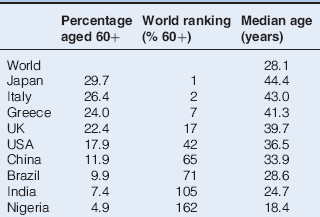
Japan’s population is the oldest in the world and most European countries have median ages of around 40 years. Population ageing is often thought of as a problem facing the developed world, but because the world’s most populous countries are less developed, nearly two-thirds of older people already live in less developed regions. This proportion has increased from approximately 50% in 1950 and is predicted to rise to around 80% by 2050 (see Figure 1.1).
Figure 1.1 Population aged 60 and over: world and development regions, 1950–2050 (UN 2009). Reproduced with permission of UN.
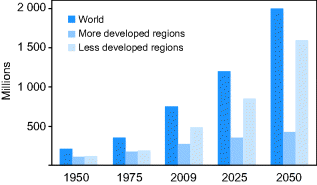
The greatest absolute numbers of older people live in China and India. An excellent online resource to look at demographic changes in different countries over time is Gapminder (http://www.gapminder.org/) – the trends with time, effects of war (e.g. France 1918, 1944; Japan 1945) and HIV (e.g. Swaziland) are readily seen.
Another important statistic for a country is its total dependency ratio, that is the number of under-15s plus the number of those aged ≥ 65 years per 100 people aged 15–64. In 2009, for the world, the sum of youth and old age dependency is around 50. In Africa the ratio is much higher due to the proportion of children. In Europe the ratio is similar to the world average but old age dependency exceeds youth dependency (see Figure 1.2).
Figure 1.2 Youth and old age dependency ratios in world regions (UN 2009). Reproduced with permission of UN.
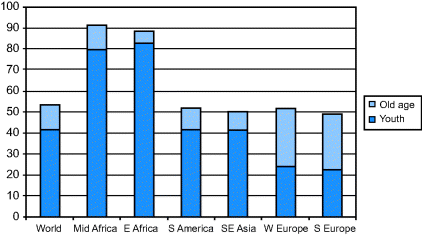
There are marked differences in the pace of population ageing between developed and less developed countries, e.g. it took 115 years (1865–1980) for the proportion of older people to double in France (from 7 to 14%) whereas in China the proportion will have doubled between 2000 and 2027. The number of older people in the world is expected to exceed the number of children for the first time in 2045. By 2030 most countries will have a similar age structure, as can be seen from the population pyramids in Figure 1.3.
Figure 1.3 Population pyramids (age in years), 1999 and 2050 (UN 2009). Reproduced with permission of UN.
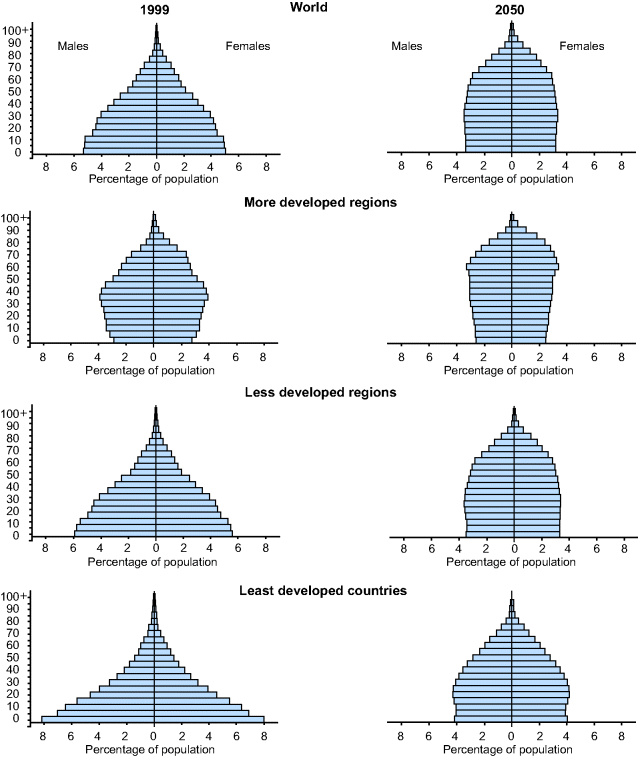
Developed Countries
Demographic Changes
- Death which was common in infancy and usual before 65 years is now rare in infancy and unusual before 65 years.
- Life expectancy continues to rise, partly due to improvements in medical care of conditions such as hypertension and ischaemic heart disease.
- The dramatic rise in the elderly population over the past 100 years is now slowing.
- However, the number of ‘old old’, i.e. those ≥ 80 years of age, is still increasing rapidly.
- The Commission on Global Ageing warns of the risk of ‘ageing recessions’ due to a fall in the size of the workforce (labour shortages) plus increased service demands (caring services). In 2010, China overtook Japan as the world’s second largest economy, due in part to the ageing and shrinking population of Japan.
Medical Services
- Sophisticated health systems are established with specialist services for the elderly.
- Population trends alone require increased health funding each year (estimated at 1% per year in the UK) in addition to inflation and costs due to technological development.
- Rising expectations of older people and their carers fuel rising health costs.
- Ethical dilemmas will be more pressing, e.g. the prolongation of death by technological intervention or medicated survival of the young chronically sick and acutely ill, and frail, elderly patients.
- Financial provision must be made to support the choices made. An elderly person costs the health services nine times as much as a young person.
- Medical training continues to concentrate on increasing specialization, so practitioners cannot cope with complex aetiologies (sociological, psychological and medical) and multi-pathology (co-morbidity), and the atypical presentations common in elderly patients, i.e. a mismatch between aspirations of young medics and the needs of their elderly patients.
Community Services
- Community care is individually based and very varied. Comparison between provision in different countries is difficult because of political, socio-economic and demographic differences. It is easier to make comparisons with regard to institutional care, usually in residential or nursing homes. There used to be marked variation between countries, but figures are converging to 5–9% of the 65+ group being in care (5.5% in 2006 in England).
- The historical development of the patterns of care is similar. In all societies there has always been a heavy reliance on self-sufficiency and family care. The healthy and wealthy old have always faired the best. For the more disadvantaged, there has always been a need to rely on support from non-family members.
- In the ‘Old World’, non-family support was originally provided by the church or by occupationally related charities or guilds. In England, the state began to become more prominent in the 17th century with the first Poor Law Act, which provided workhouse care and ‘outdoor relief’. This continued until the end of the 19th century. The 20th century saw the beginning of the welfare state – gradually growing in the first half of the century, reaching a peak mid-century and then declining towards the end of the 1980s. At the time of decline, the general move was away from the provision of services by the state to state regulation of services provided by other organizations. This regulation was gradually devolved and central control lost or weakened.
- From the 1980s onwards, an increasing number of nursing homes in the USA, and then Europe and Australia were run by profit-making organizations (increasingly large multinational companies). The for-profit companies had a worse record for staffing levels (20% less than non-profit-making institutions) and skill mix, and a higher incidence of violations of standards. There was concern that the regulatory arrangements were failing to improve or even maintain standards and costs were escalating.
- For example, in Australia, the proportion of for-profit nursing home beds was historically about 27%, but had risen to 55% by the year 2000. Between 1996 and 2000, the cost of public funding of private nursing homes rose from A$2.5 to A$3.9 billion. The cost of the regulatory system doubled, but unannounced inspections ceased, reports of inspections became more difficult to obtain and available sanctions were rarely used.
Less Developed Countries
Demographic Changes
- Once people reached old age in developing countries, their life expectancy was not much lower than in the developed world and this remains the case (Table 1.2).
- Until recently the proportion of older people in the population was low, but as countries such as China and India are so populous, over 60% of the world’s elderly population already live in these countries.
- The population structure of these countries is changing very rapidly with falling birth rates as contraceptive policies become effective (or were imposed), infant mortality is reduced and to a lesser extent as survival in adult life improves.
- Population patterns are at risk of distortion by epidemics, e.g. HIV/AIDS, civil war and migration, e.g. sub-Saharan Africa.
- European studies show that the survival of babies with low birth-weight and reduced growth in the first year leads to poor adult health – especially regarding BP and blood sugar control. This is likely to have significant consequences in India and Southeast Asia.
- Potentially preventable disabilities acquired in youth will complicate old age.
- The poor will be unable to acquire sufficient wealth to provide for themselves in old age; therefore the total burden will either fall on the state or will be neglected.
- There are many pressing financial demands for expansion, e.g. education, housing and development of infrastructure.
- Many countries struggle with debt, and political instability is common.
Table 1.2 Mean life expectancy at different ages (UN 2009). Reproduced with permission of UN.
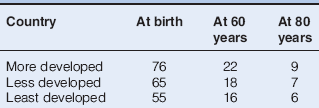
Medical Services
- Health services are often primitive, patchy and inappropriate to needs.
- ‘High-tech’ procedures for the few may be favoured over public health measures that would bring more benefit for the whole population.
- Doctors and nurses training in undeveloped countries will need expertise in elderly care because of the changing demography of their own countries. Depending on their country of origin, if they move to a developed country, they may find themselves confronted by very elderly patients for the first time.
- Development may be restricted by the tight macro-economic practices enforced by the International Monetary Fund which limit a government’s ability to invest in health.
- Globalization via the World Trade Organization has resulted in conflict over the cost of drugs. High prices for patented drugs ensure financial profits for Pharma enabling development of new drugs but developing countries need access to cheap generic drugs, e.g. for the treatment of HIV, hypertension and diabetes.
- World trade tends to encourage bad health habits, e.g. smoking, excess alcohol and recreational drug abuse.
Community Services
- The majority of the population continue to work as long as they are able and must rely on family support; retirement, at least for most people, is a concept of the developed world.
Ageing in India
India is in a rapid phase of transition. Life expectancy at birth has been increasing since the 1950s (Figure 1.4). As there are more children in India than China, by 2050 India is predicated to have overtaken China as the world’s most populous country.
Figure 1.4 India’s elderly population (UN 2009). Source: Bloom et al. (2010) Reproduced with permission of John Wiley & Sons, Inc.
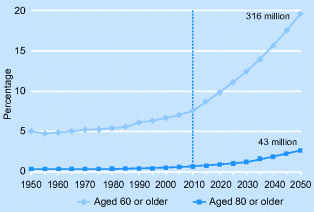
Stay updated, free articles. Join our Telegram channel

Full access? Get Clinical Tree


